Breast Enhancement
Correction of Chest Laxity And Breasts in Women

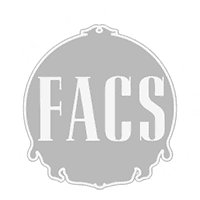


Breast Lift, Breast Augmentation, and Breast Reduction
The breasts are made up of 2 major components. Breast gland and breast fat that normally surrounds the gland core and resides under the breast skin. Weight gain typically results in an increase in both the chest fatty layers as well as breast fat. Both tissues stretch, expand, and increase in volume. Like every other tissue, breast enlargement is accompanied with breast expansion in a three-dimensional manner (vertical, horizontal, and projection). In both men and women, the breasts will become larger by storing more fat within fat cells.
In females, this can lead to macromastia – symptomatic enlargement of breasts which may be associated with neck pain, back pain, breast pain, shoulder grooving, etc. The breast skin expands and stretches while the ligaments (Cooper’s ligaments) that hold the breast gland against the chest muscle stretch out and break. Also, the connective tissue bands that hold the mammary crease (known as the inframammary fold) in place over the mid chest stretch out and lose their elasticity.
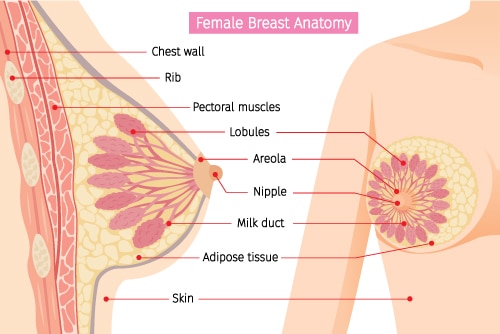
Following weight loss, the breast changes are typically universal. The fatty layers under the skin as well as the fat within the breast undergo shrinkage due to loss of fat stores. The breasts undergo mild, moderate, or severe loss of fatty tissue, depending on how much weight has been lost. For most patients, the breasts lose volume and become deflated and end up with the breast gland mainly. The damaged Cooper’s ligaments are unable to retract the breast gland to its normal position on the chest. This results in breast glands sagging in an oversized breast skin envelope that has no elasticity. Depending on the severity, there are 3 grades of breast sagging (ptosis).
- Grade I: Mild ptosis – The nipple is at the level of the inframammary crease and above most of the lower breast tissue.
- Grade II: Moderate ptosis –The nipple is below the inframammary crease but higher than most of the breast tissue hangs.
- Grade III: Advanced ptosis – The nipple is below the inframammary crease and at the level of maximum breast projection.
- Pseudoptosis – The nipple is located either at or above the infra-mammary fold, while the lower half of the breast sags below the crease. This is often seen after a previous standard breast lift.
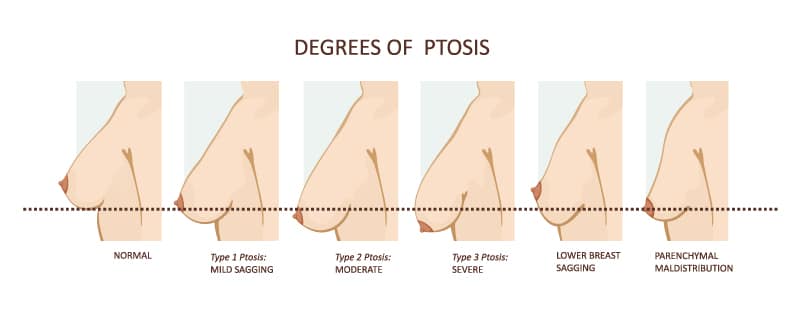
Furthermore, in many weight loss patients, the mammary crease under the breast loses its semi-circular form and becomes semi-linear over the outer aspect of the chest due to the weight of the excess abdominal tissue and back rolls. The breasts therefore displace downward and outward on the chest. They also appear broadened by the loss of outer breast tail/chest demarcation. This results in flattening and loss of breast projection which exacerbates the sagging breasts.
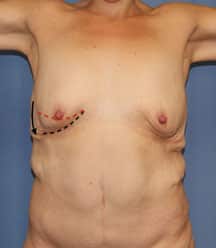
For some patients, the breasts will be completely deflated and empty, whereas others will still have large breasts. In between these extremes, there are variable breast shapes and sizes. Many of the aforementioned changes occur independently on each side of the body, and the degree of change is often asymmetrical. Thus, it is not surprising to find breasts that are uneven in many aspects, most noticeably in shape and size.
However, virtually all weight loss patients will require some form of a breast lift procedure. This is often combined with either a breast reduction or a breast augmentation.

Breast Lift
As mentioned above, all female weight loss patients will need some sort of a breast lift unless the patient has always had tiny breasts.
Some will need only the breast lift, some will need breast augmentation with a breast lift, and a few will need a breast reduction with a breast lift. Breast lift procedures are designed to lift and reshape breasts that are sagging. The breast lift procedure can be done in several different ways, depending on the desired results.
Standard breast lift techniques are categorized according to their incision placement as:
1) Peri-areolar breast lift. This is also known as a donut lift. The incision for this type of lift is only around the areola and the actual lift is very limited. This is basically a nipple- areola repositioning procedure and is typically performed for those patients who have small breasts, mild grade 1 sagging, and want breast implants.
2) Vertical Breast Lift. This is also known as the lollipop breast lift. The incision for this breast lift is around the areola and down on the breast. Through this incision, the breast tissue is lifted to the desired position and the breast is made narrower. This procedure can be done by itself or combined with breast fat transfer or breast implants. The vertical breast lift is again best used for grade 1 breast ptosis since not much skin can be taken out with this procedure.
3) Wise-pattern breast lift. This is known as the anchor-incision breast lift. This is predominantly the main and best choice for most weight loss patients since there is often a lot of skin that needs to be taken out. Through an incision that goes around the areola, down on the breast and then over the mammary crease, a large area of excess breast skin can be removed. The procedure also gives a lot of control to the surgeon through a larger access. The breast tissues can be lifted, the breast width can be narrowed, and even the mammary crease can be repositioned.
With the standard anchor-type breast lift, lifting of the breast tissue is achieved by bringing the breast skin together and closing the incisions. Although this type of breast lift works for the non-weight loss patient, for the weight loss patient, the results are often short lived since the breast skin can not hold the breast tissue in place for long.
Dermal Bra-Suspension Breast Lift and Reshaping
As mentioned above, most standard plastic surgery techniques were created for non-weight loss patients and thus are not optimal in the weight loss patient. Since 2005, Dr. Agha performs a more comprehensive breast lift procedure for the weight loss patient. The procedure, known as the dermal bra suspension mastopexy was pioneered by Drs. Agha and Rubin and has been published in several plastic surgery textbooks.
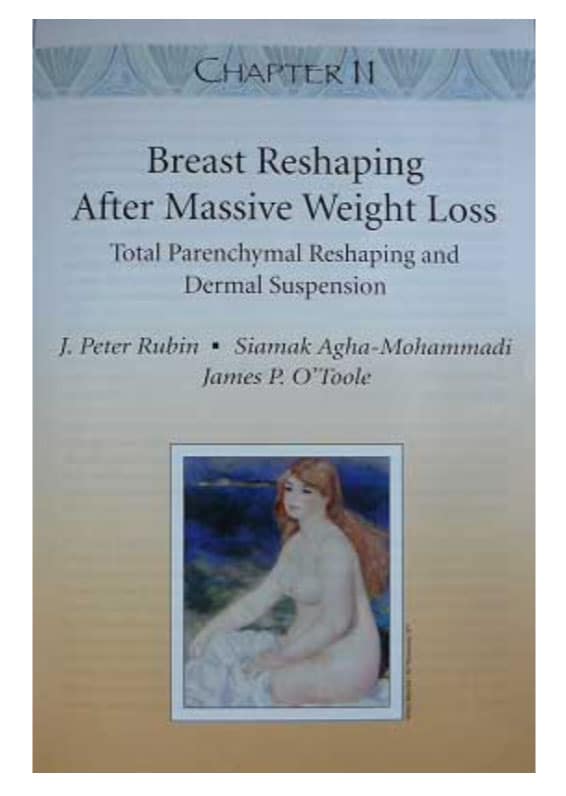
Again the main principle of this technique, like arm lift, thigh lift, or body lift, is to anchor the breast tissue to a supporting structure and not rely on the skin to hold tissue and shape in place. Since its inception, Dr. Agha has further modified and refined this procedure.
First anchor-incisions are made over the breast to remove the excess breast skin under the breast surface. The nipple areola remains on the lower breast tissue (shown below in white).
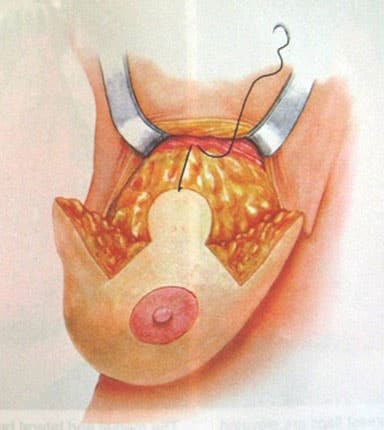
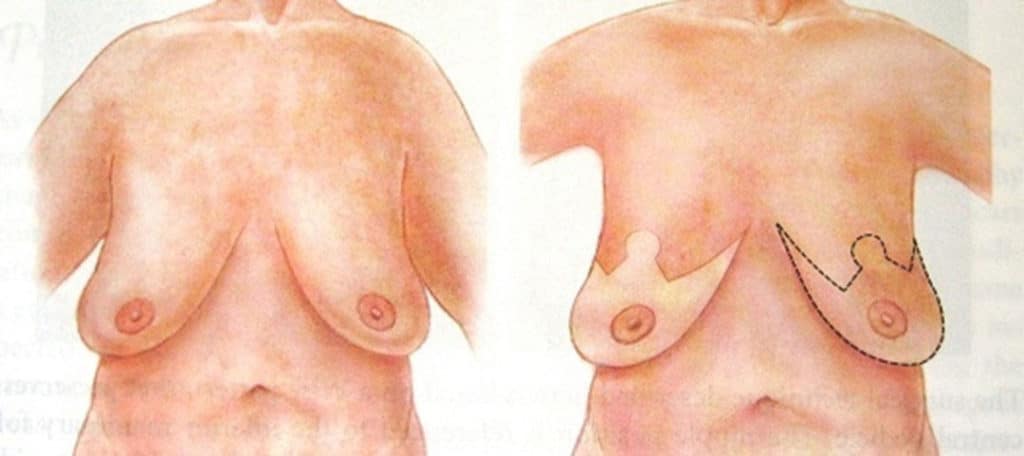
Next, the remaining upper breast skin is separated from the lower breast tissue. The breast tissue is then sutured to the rib cage at a higher, pre-planned location centrally.
The broad and flattened breast tissue is then sutured to itself to make it narrower and rounder breast, and to create projection.
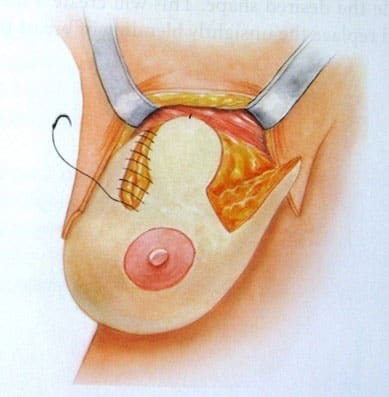

In this manner, the breast tissue is reshaped into a round breast mound. The breast mound is also anchored with sutures to the rib cage at a higher position to the rib cage. Together with the breast lift, many patients will also need to have their inframammary crease recreated as a semi-circular cease rather than a semi-linear crease.
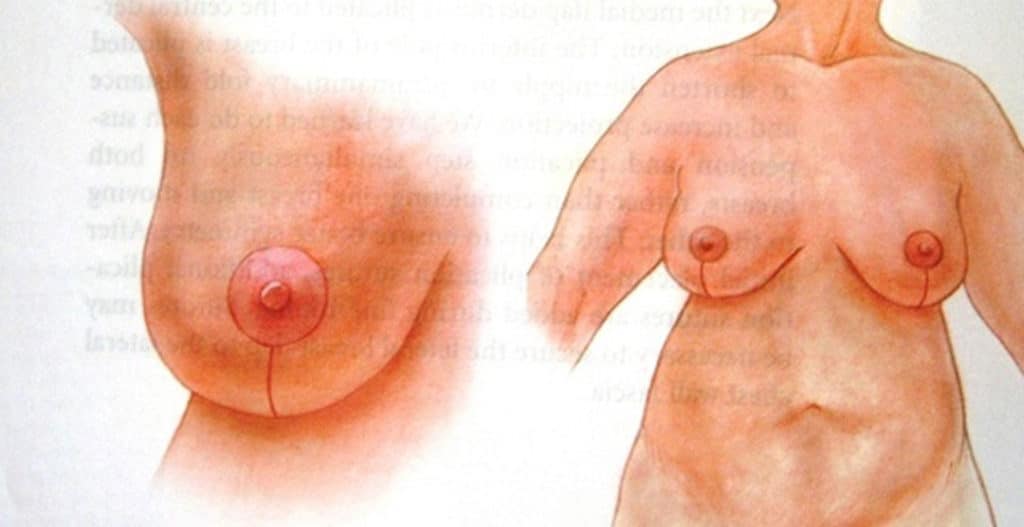
The dermal bra suspension breast lift is the most comprehensive breast lift that is available. It usually takes about 1 ½ hour longer than the standard anchor-type breast lift. This is the time needed to suture the breast tissue to itself and to create a projected breast mound that is then sutured to the rib cage at a higher position.
Dermal Bra-Suspension Breast Lift with Reconstruction of the Inframammary Crease at a Higher Position on Chest and Reshaping
Some weight loss patients will not only have sagging of breast tissue, but also descent of the whole breast unit on the chest. In these patients, the breast and the inframammary crease are too low on the chest. Instead of the breast being in the middle of the rib cage, they are often on the lower aspect of the rib cage. While, a breast lift will work successfully in lifting the nipple areola and reshaping the breasts at their current location, it does little in elevating the breast unit on the chest. These patients require reconstruction of their mammary crease at a higher position on the chest. Combined breast lift together with reconstruction of the inframammary crease at a higher location on the rib cage, not only lifts the breasts, but also repositions the lifted breasts at a higher, more anatomically correct position on the chest. Thus, the breast tissue is lifted from a higher location on the chest; creating a more powerful breast lift result.
Furthermore, the elevation and repositioning of the inframammary crease results in lifting the abdominal skin higher and tightening the upper abdomen. This is known as a reverse tummy tuck. In 2010, Dr. Agha published his experience in 88 patients who had had a reverse tummy tuck and inframammary reconstruction by himself and Dr. Hurwitz. This was the largest series of such procedures that was ever published.
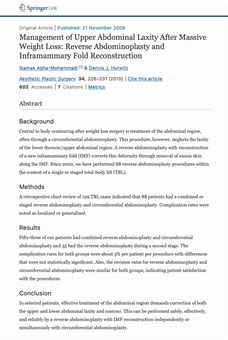
Management of upper abdominal laxity after massive weight loss: reverse abdominoplasty and inframammary fold reconstruction (2010). Agha-Mohammadi S, Hurwitz DJ. Aesthetic Plast Surg. 34(2):226-31.
Dermal Bra-Suspension Breast Reduction and Lift
Most weight loss patients will lose a significant volume of fat from both breasts. This results in loss of breast shape and ultimate sagging of the breast tissue in an over-stretched and lose breast envelope. However, rarely, a patient presents with larger than ideal breasts. For those patients with large breasts and sagging, Dr. Agha commonly performs a breast reduction with dermal bra suspension breast lift.
During this procedure, anchor-type incisions are made over the breast to remove the majority of the excess breast skin under the breast surface. Next, the excess breast tissue is removed while preserving the nipple areola complex attached to a central mass of breast tissue and gland. Following the removal of breast tissue from both breasts, breast symmetry in terms of size and shape are confirmed. Next, a dermal bra suspension breast lift is performed with the remaining breast tissue and gland.
Most weight loss patient typically do not have macromastia and only need minor breast reductions to make their breasts even. Also, it is not uncommon to reduce one breast while augmenting the other with your own fat while lifting both breasts.
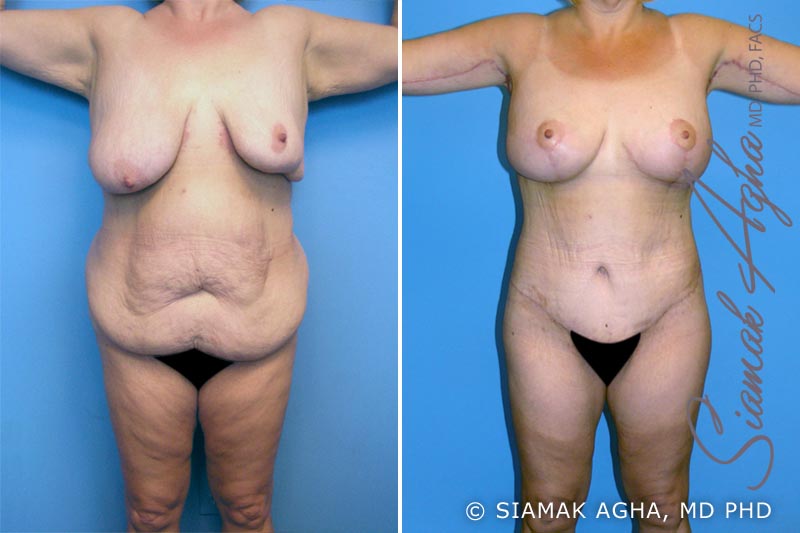
Breast Augmentation and Lift
For others weight loss patients who require breast volume, Dr. Agha offers either the use of breast implants or your own excess upper body tissue, or fat transfer.
Breast Implants And Breast Lift
When a patient has lost a significant degree of breast fat and tissue or has always had smaller breasts, then she may elect to have a breast augmentation with her breast reshaping surgery. The best way to achieve breast augmentation is through use of breast implants. Whether saline or silicone implants are chosen, Dr. Agha prefers to place the implant under the chest muscle. This produces a more natural and lasting result. The excess breast skin is then removed while the nipple areola is lifted. For those patients who do not have too much excess breast skin, a simpler breast lift (such as a donut breast lift) with breast augmentation may be sufficient. However, this is extremely rare unless the patient always had smaller breasts.
In those patients with more breast skin redundancy, then a lollipop or anchor-type incision is needed to remove the excess skin. The lollipop can be used for moderate skin excess and the anchor-type for significant skin excess.
In reality, most of our weight loss patients have ended up having the anchor-type incision since the degree of skin laxity and excess is always significant. Furthermore, by removing more skin at the time of surgery, a better and longer lasting result can be achieved.
Breast Augmentation with Upper Back Flap (Spiral Flap) And Breast Lift
This method of breast augmentation with your own back tissue was pioneered and developed by Drs. Hurwitz and Agha and was published in Plastic surgery textbook: In Aesthetic Breast Surgery by Elizabeth Finley-Hall. Autologous Breast Reshaping after Massive Weight Loss (2009). S. Agha-Mohammadi and D.J. Hurwitz.
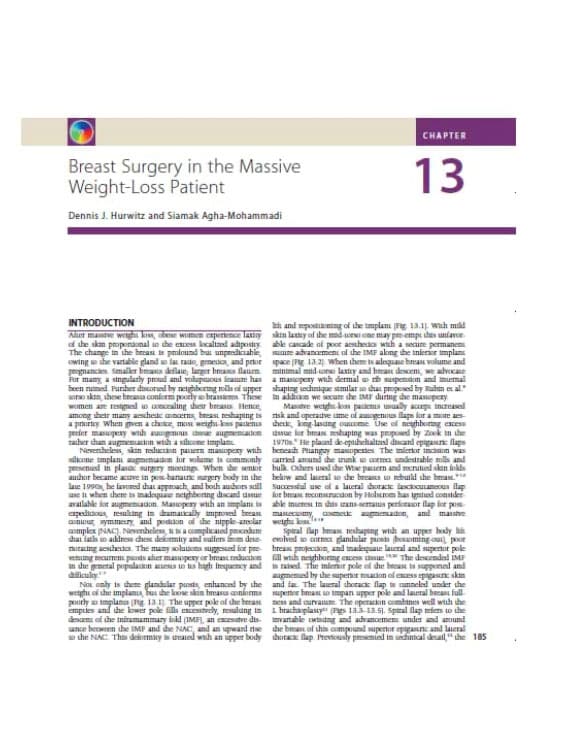
For certain patients, Dr. Agha has found this approach an effective and safe method to reshape the breast, upper chest, and back. It treats the breasts and the upper body laxity in unison, using the excess upper abdominal, chest, or upper back tissue to supplement the breast volume. Thus, both the upper body lift and breast reshaping are performed simultaneously. Although the technique is plausible, the surgery is rather complex and lengthy.

This patient presented to Dr. Agha for a total body lift in 2007. As you can appreciate, the breasts were completely different in terms of shape, size, and projection. Dr. Agha performed a dermal bra-suspension breast lift and reduction on the right side and a Spiral flap breast augmentation and lift on the left side. Both breasts were shaped naturally without the use of implants.
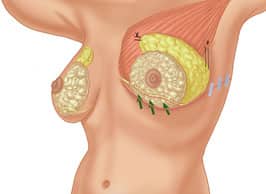

In this technique, fat taken from the back during a bra-line upper body lift is brought forward and used to augment patient’s breasts with autologous (self) tissue.
Breast Reshaping with Fat after Breast Lift
Another option to increase breast size, is breast fat transfer. Fat that has been liposuctioned from various areas is first cleaned and processed. The fat is then precisely injected into the breast to increase breast volume by about 1 cup size. For patients who plan to have breast fat transfer, Dr. Agha usually start the first stage with breast lift and reshaping. Once the breasts have healed and settled, Dr. Agha fills the breasts with fat while reshaping the breasts again. He normally places the majority of the fat in the upper and inner aspect of the breasts to create roundness and cleavage.
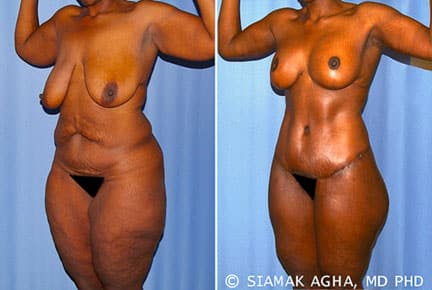
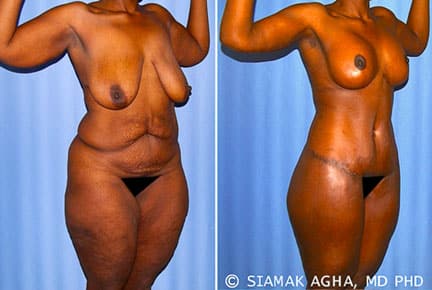
This patient presented to Dr. Agha for a total body lift in 2011. Dr. Agha performed a dermal bra-suspension breast lift for the patient as her first surgery. During her lower body lift surgery, liposuctioned fat was transferred into the breasts to create additional fullness and roundness.
In weight loss patients, Dr. Agha typically performs breast lift and reshaping, arm lift, and upper body lift surgeries together during the second stage. The combined surgeries will take about 8 hours to perform.
To learn more about recovery after breast lift, please visit our breast lift pages here.
To learn more about recovery after upper body lift, please visit our body lift pages here.
To learn more about recovery after arm lift, please visit our arm lift pages here.
